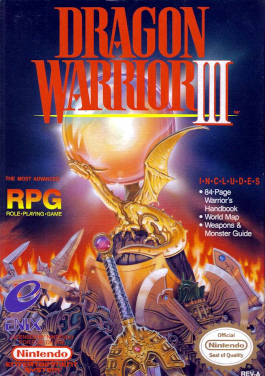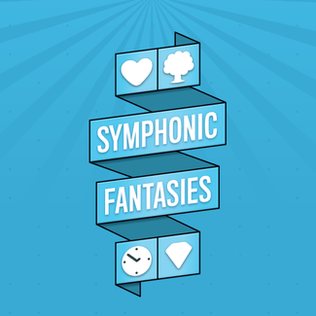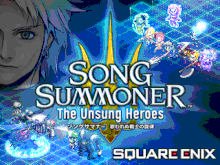
Final Fantasy IV, titled Final Fantasy II in its initial North American release, is a role-playing video game developed and published by Square for the Super Nintendo Entertainment System. Released in 1991, it is the fourth main installment of the Final Fantasy series. The game's story follows Cecil, a dark knight, as he tries to prevent the sorcerer Golbez from seizing powerful crystals and destroying the world. He is joined on this quest by a frequently changing group of allies. Final Fantasy IV introduced innovations that became staples of the Final Fantasy series and role-playing games in general. Its "Active Time Battle" system was used in five subsequent Final Fantasy games, and unlike prior games in the series, IV gave each character their own unchangeable character class — although at a few points in the story, a dark knight will choose the path of a paladin, or a summoner will evolve to a new tier of spellcasting.

Final Fantasy Adventure, known in Japan as Seiken Densetsu: Final Fantasy Gaiden or simply Seiken Densetsu, and later released in Europe as Mystic Quest, is an action role-playing video game developed and published by Square for the Game Boy. It is a spin-off of the Final Fantasy series and the first game in the Mana series.

Square Enix Holdings Co., Ltd. is a Japanese multinational holding company, video game publisher and entertainment conglomerate. It releases role-playing game franchises, such as Final Fantasy, Dragon Quest, and Kingdom Hearts, among numerous others. Outside of video game publishing and development, it is also in the business of merchandise, arcade facilities, and manga publication under its Gangan Comics brand.

Final Fantasy XII is a role-playing video game developed and published by Square Enix. The twelfth main installment of the Final Fantasy series, it was first released for the PlayStation 2 in 2006. It introduced several innovations to the series: an open world; a seamless battle system; a controllable camera; a customizable "gambit" system, which lets the player control the artificial intelligence (AI) of characters in battle; a "license" system, which determines what abilities and equipment can be used by characters; and hunting side quests, which allows the player to find and defeat increasingly difficult monsters in the game's open world. Final Fantasy XII also includes elements from previous games in the series, such as Chocobos and Moogles.

Dragon Quest III: The Seeds of Salvation, titled Dragon Warrior III when initially localized to North America, is a 1988 role-playing video game developed by Chunsoft and published by Enix. It is the third installment in the Dragon Quest series and was first released for the Family Computer (Famicom) in Japan and later for the Nintendo Entertainment System (NES) in North America. The game saw an enhanced remake for the Super Famicom in 1996 and the Game Boy Color in 2001, and a port to mobile phones and the Wii in 2009 and 2011. A version of the game for Android and iOS was released in Japan on September 25, 2014, and worldwide as Dragon Quest III: The Seeds of Salvation on December 4, 2014. It was the first time the game was given an official English subtitle. Later in 2021, another remake of the game titled Dragon Quest III HD-2D Remake, based on Octopath Traveler's style, was announced during the franchise's 35th anniversary livestream.

Dragon Quest VIII: Journey of the Cursed King is a role-playing video game developed by Level-5 and published by Square Enix for the PlayStation 2. It was released in Japan in 2004, in North America in 2005 and PAL regions in 2006, making it the first main series installment released in the PAL region. It is the eighth installment of the Dragon Quest series and it is the first English version of a Dragon Quest game to drop the Dragon Warrior title. A version of the game for Android and iOS was released in Japan in December 2013, and worldwide in May 2014.

Final Fantasy Type-0 is an action role-playing game developed and published by Square Enix for the PlayStation Portable (PSP). Released in Japan on October 27, 2011, Type-0 is part of the Fabula Nova Crystallis subseries, a set of games sharing a common mythos which includes Final Fantasy XIII and XV. The gameplay, similar to Crisis Core: Final Fantasy VII, has the player taking control of characters in real-time combat during missions across Orience. The player also engages in large-scale strategy-based battles on the world map, and has access to a multiplayer option during story missions and side quests.
Yusuke Naora is a Japanese video game art director and character designer who worked for Square Enix. A former member of Toaplan, Naora served as the art director for several Final Fantasy and Compilation of Final Fantasy VII titles. He also served as the producer of the Code Age franchise. On October 1, 2016 he announced on Twitter that he had left the company, but would continue to contribute to Square Enix games as a freelancer.
The Mana series, known in Japan as Seiken Densetsu, is a role-playing video game series from Square Enix, created by Koichi Ishii. The series began as a handheld side story to Square's flagship franchise Final Fantasy, although most Final Fantasy-inspired elements were subsequently dropped, starting with the second installment, Secret of Mana. It has since grown to include games of various genres within the fictional world of Mana. The music of the Mana series includes soundtracks and arranged albums of music from the series, which is currently composed of Final Fantasy Adventure and its remake Sword of Mana, Secret of Mana, Trials of Mana, Legend of Mana, Dawn of Mana, Children of Mana, Friends of Mana, Heroes of Mana, Circle of Mana, and Rise of Mana. Each game except for Friends and Circle has produced a soundtrack album, while Adventure has sparked an arranged album as well as a combined soundtrack and arranged album, Legend of Mana has an additional promotional EP, and music from Secret and Trials were combined into an arranged album. For the series' 20th anniversary, a 20-disc box set of previously-released albums was produced, as well as an album of arrangements by Kenji Ito, composer for several games in the series.

The World Ends with You is an action role-playing game co-developed by Square Enix and Jupiter for the Nintendo DS. Set in the modern-day Shibuya shopping district of Tokyo, The World Ends with You features a distinctive art style and urban fantasy elements inspired by Shibuya and its youth culture. Development was inspired by elements of Jupiter's previous handheld game, Kingdom Hearts: Chain of Memories. It was released in Japan in July 2007, and in PAL regions and North America in April 2008. Later, an enhanced port by h.a.n.d. for mobile devices was released in 2012 under the title The World Ends with You: Solo Remix, while another enhanced port for the Nintendo Switch was released worldwide in 2018 under the title The World Ends with You: Final Remix.
Matrix Corporation, commonly referred to as Matrix Software, is a Japanese video game development company located in Tokyo. Founded in July 1994 by former members of Climax Entertainment and Telenet Japan, the company has since created games for a number of systems beginning with their action-adventure game title Alundra in April 1997. Matrix has teamed with other developers such as Square Enix and Chunsoft to produce games for existing franchises such as Final Fantasy and Dragon Quest, as well as other anime and manga properties. In addition to game console development, Matrix Software has also made games for various Japanese mobile phone brands since 2001.

Dissidia Final Fantasy is a fighting game with action role-playing elements developed and published by Square Enix for the PlayStation Portable as part of the campaign for the Final Fantasy series' 20th anniversary. It was released in Japan on December 18, 2008, in North America on August 25, 2009, and in Australia and Europe in September. It was then re-released in Japan, based on the North American version, as Dissidia Final Fantasy: Universal Tuning, on November 1, 2009.

Crystal Defenders is a set of two tower defense video games developed and published by Square Enix. The games use the setting of Ivalice and design elements from Final Fantasy Tactics A2: Grimoire of the Rift, forming part of the wider Final Fantasy franchise. The games feature a selection of characters sporting Final Fantasy-based character classes, and play out tower defense scenarios against recurring series of monsters. The first game in the series is Crystal Guardians, which was released in three parts for Japanese mobile phones in 2008. It was adapted for iOS later that year as Square Enix's first game for the platform, and renamed Crystal Defenders. Under that name, the game was also released between 2009 and 2011 for Android, Xbox Live Arcade, WiiWare, and PlayStation 3 and PlayStation Portable via the PlayStation Store. It was re-released with graphical improvements for iOS as Crystal Defenders Plus in 2013. A sequel, Crystal Defenders: Vanguard Storm, was released for iOS in 2009.

Tidus is a character in Square Enix's Final Fantasy series and the main protagonist of the 2001 role-playing video game Final Fantasy X. Tidus is a 17-year-old from the city of Zanarkand who is transported to the world of Spira following an attack by the creature Sin. Shortly after his arrival he meets and joins Yuna, a summoner and her guardians in a pilgrimage to kill Sin, in the hope he can find a way home. He has appeared in other video games, including the Final Fantasy X sequel X-2, the Kingdom Hearts series, and several Square Enix crossover games.

Final Fantasy Dimensions is a role-playing video game developed by Matrix Software and published by Square Enix for mobile devices. Similar to Final Fantasy IV: The After Years, it was initially released as an episodic game, with the first two installments released in September 2010 on the Japanese i-mode distribution service, and in December 2010 for the EZweb distribution service. The game was remade for the iOS and Android platforms and released internationally in August 2012.

Theatrhythm Final Fantasy is a rhythm video game, developed by indieszero and published by Square Enix for Nintendo 3DS and iOS. Based on the Final Fantasy video game franchise, the game involves using the touch screen in time to various pieces of music from the series. The game was released in Japan in February 2012, and in North America, Australia and Europe in July. An iOS version was released in December. A sequel, Theatrhythm Final Fantasy: Curtain Call, was released in 2014. A third game based on the Dragon Quest series, Theatrhythm Dragon Quest, was released in 2015. An arcade game, Theatrhythm Final Fantasy: All-Star Carnival, was released in 2016. A second sequel, Theatrhythm Final Bar Line, was released on February 16, 2023 for Nintendo Switch and PlayStation 4.

Symphonic Fantasies: Music from Square Enix was an award-winning symphonic tribute concert originally held in Cologne, Germany on September 12, 2009, at the Cologne Philharmonic Hall featuring video game music from Japanese game developer Square Enix. The concert featured symphonic movements based on the Kingdom Hearts series, Secret of Mana, the Chrono series, and the Final Fantasy series. It was produced and directed by Thomas Böcker, with arrangements provided by Finnish composer and musician Jonne Valtonen with assistance by Roger Wanamo. Due to overwhelming demand, a second concert was added at the König-Pilsener-Arena in Oberhausen, on September 11, 2009. Both performances were by the WDR Radio Orchestra Cologne and the WDR Radio Choir Cologne under conduction from Arnie Roth, with guest performers Rony Barrak and Benyamin Nuss joining the orchestra. Symphonic Fantasies was broadcast over radio on the WDR4 station and streamed live video online.

Dissidia Final Fantasy NT is a fighting game with action role-playing elements developed by Koei Tecmo's Team Ninja and published by Square Enix for PlayStation 4 and Windows.
















